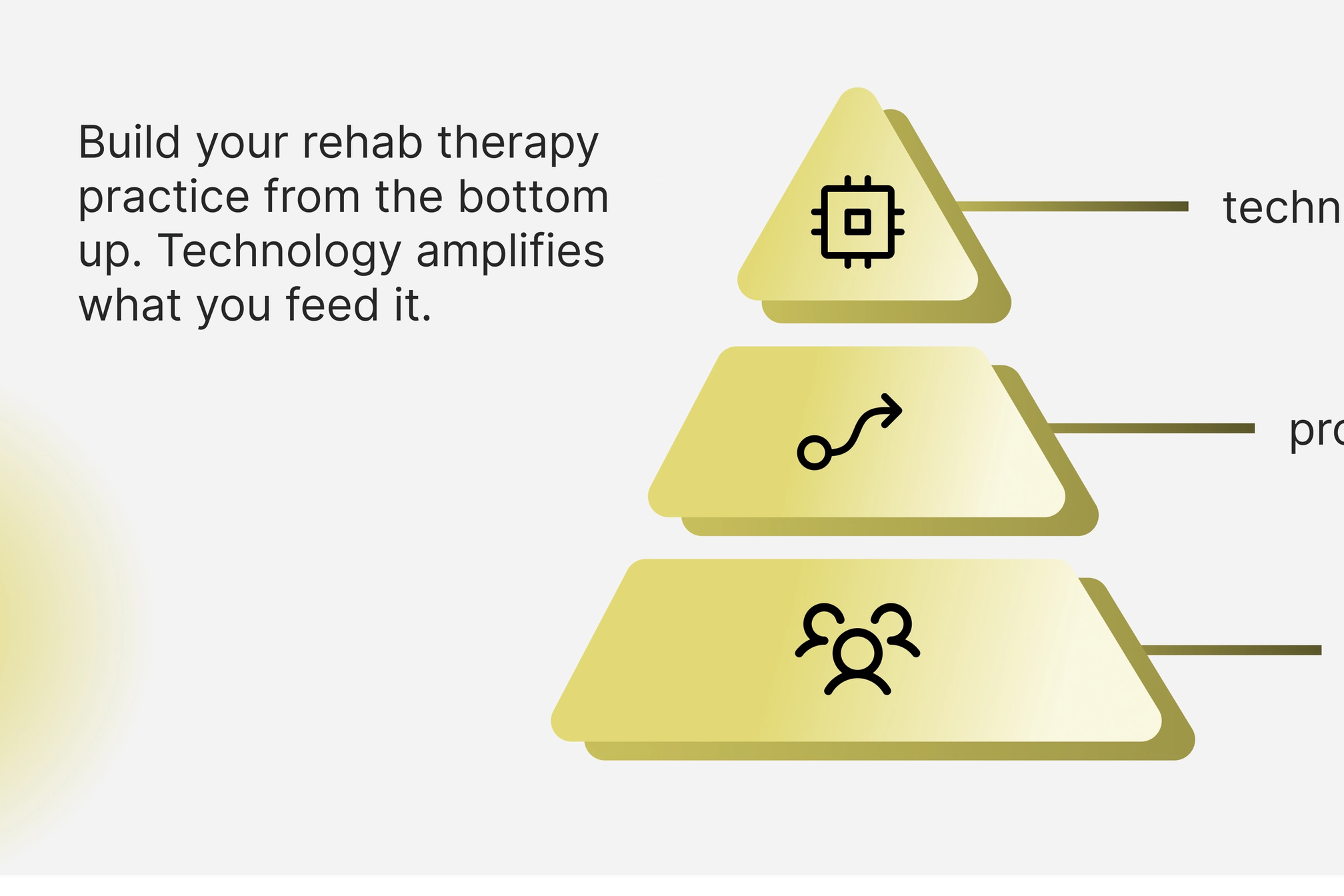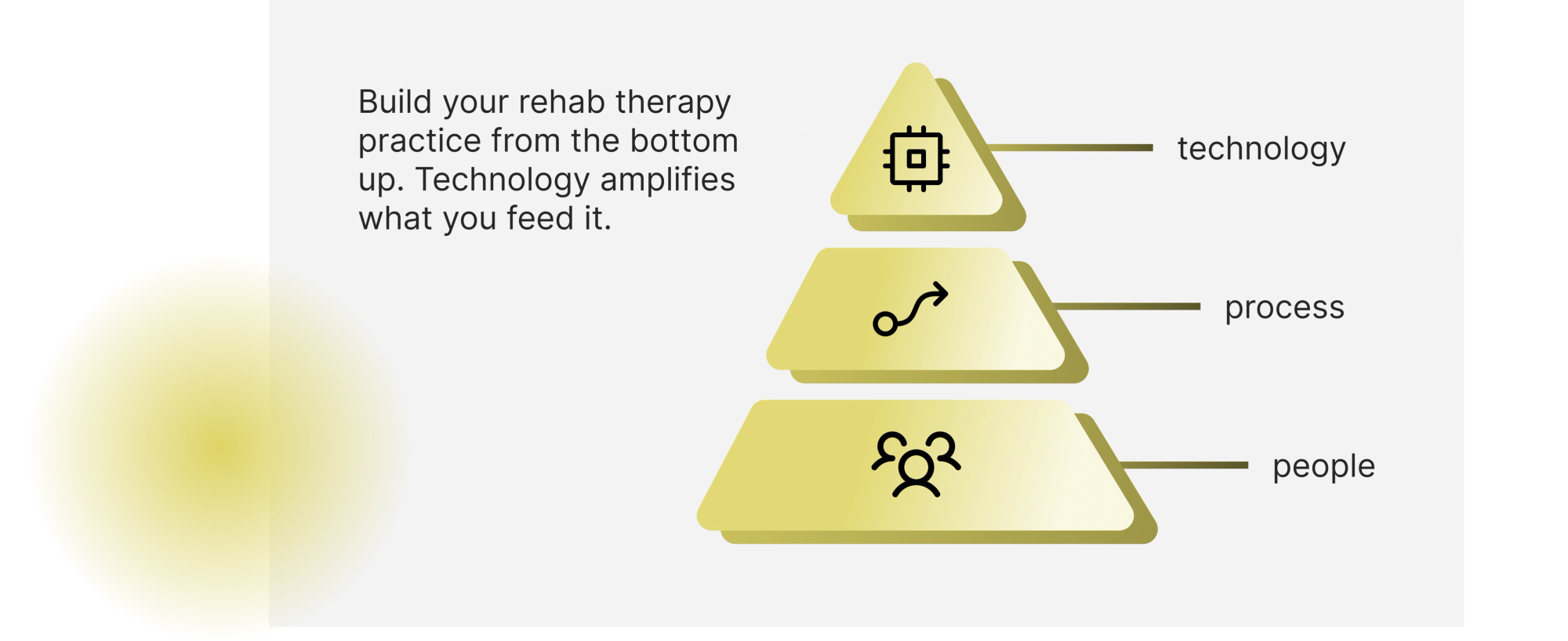Thursday, November 6, 2025
Respect the People-Process-Technology Hierarchy, Or Watch Your Therapy Practice Fail

When Jerry Durham was contemplating whether to take his physical therapy practice out of network in the mid-2000s, all of his peers told him he shouldn’t do it. After all, why would patents pay out of pocket when they could get the same thing covered by insurance?
Durham proved them wrong by building a seven-figure practice that thrived without insurance contracts. He succeeded because he remembered and continuously reminded himself of something that other practices often forget: A practice is ultimately a business, and patients need to be treated like the consumers that they are.
Your patients aren’t unique
Many independent rehab therapy practices assume that patients are fundamentally different from other consumers.
They aren’t.
Patients make purchasing decisions based on cost and value, like any other consumer. So just like any other consumer, they need to know what they’re buying to make an informed decision about whether the service will solve their problem and is worth the cost.
But many don’t know what they’re buying.
Durham learned this during a year when he personally answered every call that came into his practice. Rather than starting conversations by discussing insurance, he would ask callers a simple question: “Why did you call today?”
The answers showed that patients lacked clarity about what they were getting. They were like shoppers walking into a grocery store asking for cereal without knowing if they needed flakes, hoops, or puffs, or whether the store had them in stock. At a high level, they knew they needed “physical therapy,” but they had little understanding of the specific service they needed and whether Durham’s practice actually offered it.
When patients don’t fully understand what they’re getting into, they ask about price and insurance coverage instead of exploring whether a practice can actually solve their problem. Front desk staff, focused on filling the schedule, respond by trying to get patients booked quickly rather than ensuring patients know what they’re signing up for. This creates a knowledge gap that leads to downstream problems, such as no-shows, cancellations, and low utilization rates.
Many practices lose a good chunk of patients before completing treatment, then claim they provide quality care. Durham calls out the contradiction, “If you’re churning 40–50% of your business. No, you don’t care about patients.”
“If you’re churning 40–50% of your business. No, you don’t care about patients.”
The people-process-technology hierarchy
Addressing churn matters for both patient and business health. Patients deserve to complete their treatment and achieve positive outcomes. Meanwhile, practice stability and longevity require a model that isn’t dependent on constantly replacing lost patients.
To achieve both, independent rehab therapy practices need to tackle the disconnect between patients and the services they receive.
For practices wondering where to begin, Durham recommends they start by understanding the people on the other end of the phone. From there, practices can develop thorough qualification processes and, only then, use technology to scale what works.

People first: Understand the healthcare consumer
Practices must change the mindset that the patients they serve are different from consumers in other industries.
“We in healthcare believe we live in the most unique niche on the face of the earth, and it is the biggest damn lie,” says Durham. “We tell ourselves every day it’s different. But it’s not. At the end of the day, we’re dealing with people.”
When practices accept that patients are consumers, they can have honest, exploratory conversations about what patients actually need and what their practice offers. “We’re all owed the same conversation to understand what we are paying for, and that is missing insanely,” Durham shares.
"We in healthcare believe we live in the most unique niche on the face of the earth, and it is the biggest damn lie. We tell ourselves every day it’s different. But it’s not. At the end of the day, we’re dealing with people.”
Process second: Qualify before scheduling
Many practices schedule everyone who calls and leave it to providers to weed out mismatched patients after they arrive.
At that point, it's too late to determine there’s a bad fit. This delay in screening wastes the time of a patient who desperately needs care to regain function and a therapist who wants to do the job they spent years training to do.
Durham takes a different approach. He uses the information gathered from exploratory conversations to determine who should be scheduled for an appointment. “Not all people who call your clinic today should be scheduled,” Durham states. Acting on this idea prevents what he calls the “death spiral,” i.e., when practices maintain long waitlists of paying customers while scrambling to fill last-minute cancellation spots, leading to delayed or lost revenue.
With a proper qualification process, instead of constantly putting out scheduling fires, healthcare practices can prevent them from breaking out. “You don’t wanna fill cancel slots,” warns Durham. “You want to prevent the cancel call altogether.”
This mirrors what successful salespeople do in every other industry. They listen to understand the customer’s problem, then align their solution with the buyer’s needs before moving forward.
Technology last: Use AI to amplify the good, not the bad
Durham’s recent experiments with AI voice agents validated his qualification process.
When he programmed it into a voice agent to autonomously handle patient intake calls, the results were remarkable. “I was grinning from ear to ear. I was like holy crap, that’s what my process is supposed to sound like,” he reflects.
However, when Durham listened to examples of other users employing the platform, he encountered some of the worst intake calls he’s ever heard. “Those are the people I secretly call who don’t have a process. Don’t have a system. Don’t know what they are selling. They’re putting people on the schedule based on their insurance,” Durham explains. “And now they took that same process and built it into an AI.”
Technology amplifies whatever you feed it. Without solid processes rooted in human understanding, AI simply automates dysfunction at scale. “AI needs people more than it needs a platform,” says Durham. “You have to understand people and process before you need to understand AI.”
"AI needs people more than it needs a platform. You have to understand people and process before you need to understand the AI.”
Business principles are the foundation for long-term success
Independent rehab therapy practices need to think like businesses and treat their patients like consumers if they want to compete effectively and continue to grow.
Reflecting on the importance of the business-focused mindset, Durham warns, “If you don’t understand core business principles, if you don’t understand marketing to sales to retention, if you don’t understand finances, if you don’t understand cash flow, you are not going to survive going into this next decade.”
“business principles rehab therapy practices need to master.”
Getting the business fundamentals right will help practices not only retain patients and provide quality care but also truly take advantage of new technology, all of which are increasingly necessary for long-term success.
For example, the shift from fee-for-service to value-based care means that practices can’t afford to churn through patients and rack up incomplete treatment plans anymore. “Those days are over,” says Durham. Meanwhile, digital physical therapy providers are rising up, using technology to create the user-friendly, accessible experiences patients have come to expect from other industries.
To keep up, independent practices must do the same.
